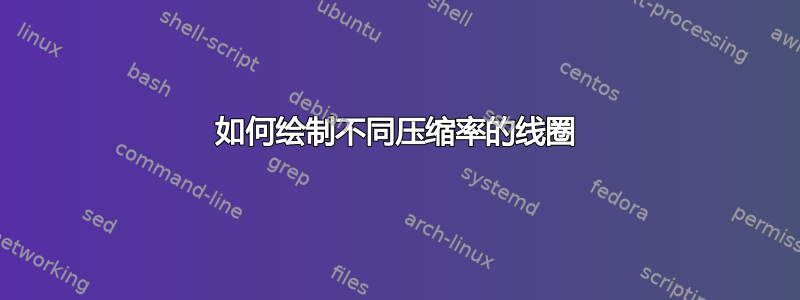
我正在尝试绘制一个具有不同压缩率的线圈,沿着下面的图片(不是我的)的线。
我考虑过把两个不同压缩比的线圈并排画出来
\usetikzlibrary{decorations.pathmorphing,patterns}
\begin{tikzpicture}
\draw[decoration={aspect=0.3, segment length=4mm, amplitude=4mm,coil},decorate] (0,0)
-- (2,0);
\draw[decoration={aspect=0.3, segment length=2mm, amplitude=4mm,coil},decorate] (0,0)
-- (-2,0);
\end{tikzpicture}
但从压缩线圈到非压缩线圈的过渡并不十分顺利。有人知道如何解决这个问题吗?
答案1
这只是一个疯狂的建议(有点碰运气,因为我没有时间找出正确的数字,但是......)。
你可以画一个恒定大小的线圈但使用余弦函数扭曲 x 坐标。
\documentclass[border=10pt]{standalone}
\usepackage{tikz}
\usetikzlibrary{decorations.pathmorphing,patterns}
\usepgfmodule{nonlineartransformations}
\makeatletter
\def\mytransformation{%
\pgfmathsetmacro{\myX}{\pgf@x + 2*cos(\pgf@x*8)}%
% no need to change y --- let's comment this out
% \pgfmathsetmacro{\myY}{\pgf@y}
\setlength{\pgf@x}{\myX pt}%
% \setlength{\pgf@y}{\myY pt}
}
\makeatother\begin{document}
\begin{tikzpicture}
\begin{scope}
\pgftransformnonlinear{\mytransformation}
\draw[decoration={aspect=0.3, segment length=2mm, amplitude=4mm,coil},decorate]
(0,0) -- (10,0);
\end{scope}
\end{tikzpicture}
\end{document}
答案2
完成 Rmano 答案后我提出以下代码:
\documentclass[border=10pt]{standalone}
\usepackage{tikz}
\usetikzlibrary{decorations.pathmorphing,patterns}
\usepgfmodule{nonlineartransformations}
\makeatletter
\def\mytransformation{%
\pgfmathsetmacro{\myX}{\pgf@x + 2*cos(\pgf@x*8)}
%\pgfmathsetmacro{\myY}{\pgf@y}
\setlength{\pgf@x}{\myX pt}
%\setlength{\pgf@y}{\myY pt}
}
\makeatother
\begin{document}
\begin{tikzpicture}
\begin{scope}
\pgftransformnonlinear{\mytransformation}
\draw[cyan,line width=1pt,decoration={aspect=0.3, segment length=2.5mm, amplitude=4mm,coil},decorate]
(0,0) -- (10,0);
\end{scope}
\draw (0,-.5) -- (10,-.5);
\foreach \i in {0,.1,...,10}
\draw[line width=.2pt] (\i,-.5)--(\i,-.6);
\foreach \i in {0.5,1.5,...,9.5}
\draw[line width=.4pt] (\i,-.5)--(\i,-.7) node[below] {\tiny $\i$};
\foreach \i in {0,1,...,10}
\draw[line width=.8pt] (\i,-.5)--(\i,-.8) node[below] {\footnotesize \bfseries $\i$};
\node at (5,-1.3) () {\footnotesize cm};
\draw[line width=.05pt] (.57,.6)--(.57,-.4)
(2.09,.6)--(2.09,-.4)
(3.61,.6)--(3.61,-.4)
(5.13,.6)--(5.13,-.4)
(6.65,.6)--(6.65,-.4)
(8.17,.6)--(8.17,-.4)
(9.685,.6)--(9.685,-.4)
(.57,.6)--(9.685,.6);
\foreach \i in {1.3,2.82,4.34,5.86,7.38,8.9}
\node[fill=white] at (\i,.6) () {\tiny $\lambda=1.52$};
\end{tikzpicture}
\end{document}
输出为:
您可以在其中注释或删除标尺的代码。
编辑: 没有统治者
\documentclass[border=10pt]{standalone}
\usepackage{tikz}
\usetikzlibrary{decorations.pathmorphing,patterns}
\usepgfmodule{nonlineartransformations}
\makeatletter
\def\mytransformation{%
\pgfmathsetmacro{\myX}{\pgf@x + 2*cos(\pgf@x*8)}
%\pgfmathsetmacro{\myY}{\pgf@y}
\setlength{\pgf@x}{\myX pt}
%\setlength{\pgf@y}{\myY pt}
}
\makeatother
\begin{document}
\begin{tikzpicture}
\begin{scope}
\pgftransformnonlinear{\mytransformation}
\draw[cyan,line width=1pt,decoration={aspect=0.3, segment length=2.5mm, amplitude=4mm,coil},decorate]
(0,0) -- (10,0);
\end{scope}
% \draw (0,-.5) -- (10,-.5);
% \foreach \i in {0,.1,...,10}
% \draw[line width=.2pt] (\i,-.5)--(\i,-.6);
% \foreach \i in {0.5,1.5,...,9.5}
% \draw[line width=.4pt] (\i,-.5)--(\i,-.7) node[below] {\tiny $\i$};
% \foreach \i in {0,1,...,10}
% \draw[line width=.8pt] (\i,-.5)--(\i,-.8) node[below] {\footnotesize \bfseries $\i$};
% \node at (5,-1.3) () {\footnotesize cm};
\draw[line width=.05pt] (.57,.6)--(.57,.3)
(2.09,.6)--(2.09,.3)
(3.61,.6)--(3.61,.3)
(5.13,.6)--(5.13,.3)
(6.65,.6)--(6.65,.3)
(8.17,.6)--(8.17,.3)
(9.685,.6)--(9.685,.3)
(.57,.6)--(9.685,.6);
\foreach \i in {1.3,2.82,4.34,5.86,7.38,8.9}
\node[fill=white] at (\i,.6) () {\tiny $\!\lambda{=}1.52\!$};
\end{tikzpicture}
\end{document}
...还有一些小变化!






